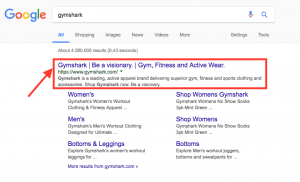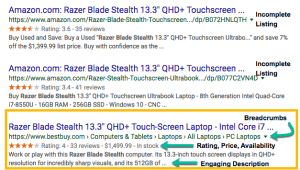The internet has made it easier than ever to find the perfect product. Although, with so many options, how can you identify which one is best for you? That’s where an e-Commerce SEO-optimized site comes in!
To increase the exposure of your eCommerce store, you need a robust SEO approach. Some factors contribute to search engine optimization (e.g., keywords, meta tags, page content). Small businesses and new entrepreneurs may find it difficult to know where to start.
With these 10 quick tips, your eCommerce store will be on its way to success and ranking higher than ever before.
Table of Contents
What Is eCommerce SEO?
eCommerce SEO is the process of boosting search engine presence. Four main components can have an impact on your eCommerce store SEO:
- Onsite optimization
- Keyword research
- Link building and social media marketing
- Offsite SEO (referring to the rest of your website)
eCommerce stores need to know how each one can help them reach their goals.
11 Proven Ways to Improve eCommerce Store SEO
1. Make the Mobile Experience Smooth
Mobile user experience is an important factor to consider when it comes to eCommerce store SEO.
Statistically, 80% of all online searches are done on mobile devices, so if your site isn’t optimized for mobile and doesn’t load quickly or offer the same experience on desktop computers, then you’re missing out!
The first step in making sure your website has an optimal user experience from any device would be checking how fast pages are loading with Google PageSpeed Insights.
| Recommendation – I recommend optimizing images by compressing them; doing this can help create smaller file sizes, resulting in faster web page loads.
And lastly, try using HTML instead of Adobe Dreamweaver because it won’t slow down the browser. |
2. Efficient Keyword Research and Set-Up
This is selecting keywords relevant to your product and then using them in content, titles, headings, tags, meta descriptions, etc.
It is important to understand that not all keywords are created equal.
| Pro Tip – It would be more beneficial for SEO if you used “women’s dresses” than just “dresses“. |
Some suggestion on setting up appropriate keywords:
- A strong strategy for selecting keyword phrases is to blend the most popular search queries and optimized terms.
- It’s also a good idea to utilize keyword phrases that are less common and specific, as long as they’re not too obscure.
- This makes eCommerce store SEO different from other forms of advertising: you are appealing to potential customers rather than selling a product directly to the person.
3. Optimize Title Tags & Meta Descriptions for Targeted Audience
Title Tags
Include a short and concise title that is descriptive of your page. This will help search engines identify what the content on the webpage relates to, as well as helping people find it when they are searching for something specific.
It’s also important not to use any symbols or capital letters in this section because web crawlers can misinterpret these – so stick with lowercase lettering only!
Meta Description
It should be about 155-160 characters long and provide a detailed description of the web page’s content, telling search engines what the web page is about.
When writing your meta description, it’s essential to include keywords related to your content because It can assist you in achieving a higher Google ranking.
4. Optimize Your Product Images
Your eCommerce store’s product images are your storefront. They’re the first thing that potential customers will see when they’re browsing your site.
Product images are the first chance you have to convince potential customers that they want to buy your product, and visuals can account for up to 95% of a purchase decision.
Product image optimization includes:
- Make sure your product images are relevant to the goods you’re selling so that people can easily find them.
- Reduce your product image size to optimize and using keyword-rich titles, descriptions, and ALT text to help web crawlers identify what is in the image.
- Use high-quality product images to enhance your website’s SEO.
- Take a variety of images, including closeups and action shots.
5. Optimize Your Site URL for Search Engines Crawls
The URL of your store is more crucial for SEO than it may seem to be. It’s important to have a clear URL so that your audience can quickly find the content they are looking for on your site.
URLs like “productname” or “category” will not help you rank well in Google SERP because the page does not provide enough information to satisfy a user’s search query.
Here are some tips to help you optimize your e-commerce store’s URL:
- Create a clean and short URL to help your visitors in finding the content they are looking for.
- Use relevant keywords in the page’s title so that search engine crawlers can easily identify what is being talked about on this page.
- Optimize your URLs by making them specific to the topic you’re writing about while keeping them as short and readable as possible.
- Use keywords related to your store in the URL of each page you publish on your site, but don’t go overboard with keyword stuffing.
- Your URLs should be readable by both humans and search engine crawlers.
6. Avoid Duplicate Content
When it comes to eCommerce website SEO, duplicate content can be a serious detriment. Since search engine crawlers are less likely to rank a page that they’ve seen before.
- Create fresh content so that each post is unique and filled with new information.
- Avoid copying or scraping from other websites, including your own; this can lead to duplicate content issues in the future if you update the copied material on one site.
- Creating a fresh and quality product description is a great way to increase your SEO rankings and attract more customers with high conversion rates who will come back for more of what you offer.
Why avoid duplicate content?
|
7. Write Compelling Product Descriptions
A well-written description can improve conversion rates by making it easier for searchers to see what you offer and convincing potential buyers to buy.
It increases the chances that visitors will discover your products on search engine results pages.
Some of the proven tips for creating converting product description are:
- Product descriptions should answer questions like “What is the product?” and “Why would I want this?“
- The product description should be a mix of short and long sentences.
- It is important to include key features, the benefits it provides, where it’s made, what colors are available (if applicable), dimensions/sizes, how much weight the item weighs if relevant, return policy information including details on any time frames or requirements for how to measure and how many people it can accommodate (if applicable).
- Provide a clear description of your products by including keywords that define what customer you are targeting, e.g., fashionista, sports fan, and pet owner.
- Make sure that the product description doesn’t make a similarity with the content on the page.
- If you have an inactive product, include a message informing customers of its status such as “Discontinued” or “Currently out of stock“.
- Include a call to action like “Check Availability” or “Shop Now“.
8. Use Rich Snippets
If you don’t have rich snippets on your eCommerce store, you’re missing out on customers.
Rich snippets are a way of connecting your e-commerce store with Google to provide more information about products, services, and brands in search results.
This includes things such as star ratings, product availability, and pricing.
You can also include the price based on location or how other customers have reviewed items.
How to Implement Rich Snippets?You need to add schema markup that appears within the HTML code of your site’s pages where relevant content is present. Various online tools will guide you by adding it manually or automatically (depending on what type of platform you’re using) to create this markup. The kind of tool needed varies depending on if you’re using WordPress/Magento/Shopify etc. |
9. De-Index Thin Content Pages
eCommerce SEO aims to attract customers and make them want to linger on your site, so they are more prone to purchase something from your store.
If you have content that is not keyword-rich, don’t waste time and space given to your eCommerce site by including it.
Thin content pages will confuse search engines and human visitors alike.
10. Avoid Broken Links
Keep your site organized and free of broken links.
When a visitor clicks on a URL and goes to another page that is redirected back to the eCommerce store because the URL that didn’t match up with where they wanted to be will likely not come back.
Suppose you have an old or outdated website. In that case, it may contain many broken links within its content, severely impacting SEO ranking for future visitors trying to find pages through search engines.
Doing these things should help improve eCommerce SEO stores’ visibility online and drive more revenue into their business as well!
11. Create ‘Best of’ Guides for Top Product Categories
You could save your readers hours by compiling “best-of” guides for them. This way, they can focus on the research stage and provide their top product recommendations to get them started!
These guides may be organized as a product guide, buyer’s guide, or best brand list.
When putting together these lists, you should include products relevant to your target audience and complement each other well.
This will help boost search engine rankings for specific keywords and provide an opportunity to cross-promote products with one another, leading to increased conversion rates for eCommerce stores as well!
This tactic can be used on social media sites like Pinterest by creating boards with pictures of each item from within that category.
| Pro-Tip – It’s essential to keep these guides updated, so customers know what brands you’re currently carrying or which ones have just been released! |
Frequently Asked Questions About eCommerce Store SEO
Is SEO Worth It for eCommerce?
Yes, since it can enhance your SERP results for your eCommerce store.
When people do a Google or Bing search and find you on page one of the SERPs (search engine result pages), they are more likely to click through to visit your site, increasing traffic and sales for your business.
How Can I Improve My SEO Fast?
Hire a professional eCommerce SEO specialist to help you.
SEO isn’t easy, but many things can be done, like optimizing your images and creating a readable copy. It takes time and patience to rank higher on search engine result pages with SEO; however, it well worth the wait.
How Can I Improve My Product Page?
Start with the basics: using a large, clear, and attractive image of your product. Put together compelling copy that tells people what to expect why they buy your item.
Add keywords in the title and the description tags, so you get found by Google’s search algorithm while optimizing images for high-quality SEO ranking on all other sites like eBay or Amazon.
Remember, it’s time to get creative! The most successful eCommerce stores are the ones that stand out and do things differently than competitors, so use your creativity to come up with campaigns or offers which will set you apart from other online shops.
| Pro Tip – if your store sells clothes: offer a monthly clothing subscription service like Stitches. |
Bottom Line – SEO tips for eCommerce store
The more you know about how people search for products online, the better equipped you are to improve your E-commerce store SEO.
These 11 proven ways will help you get started on ensuring that every customer who visits your site finds what they’re looking for and then some.
If you are still unsure you can improve your eCommerce site SEO, eMojo digital can help you and offer expert consultation.
Their SEO professional will review everything from your title tags to the images on your website to maximize the visibility in SERPs.


















